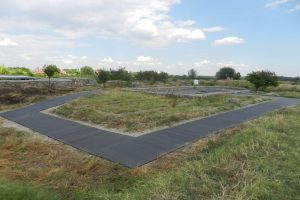

Radu Greceanu’s bust is placed in the courtyard of the National College Radu Greceanu educational institution with a history of over 130 years.
Radu Greceanu (born approx. 1655/1660 – Death ante July 9, 1725) was a Muntenian chronicler, author of the chronicle Life of Constantin Brancoveanu from 1711 and the manuscript “Chronicle of the first dismounting of Romanians and their settlement in Romanian Country”, which was lost.
The scribe Radu Greceanu along with his brother, scribe Serban Greceanu took part, along with Constantin Cantacuzino and with the support of high priest Ghermano of Nyssa (director of the Greek Academy in Constantinople) and and of Sevastos Kymenites (headmaster of the Greek School in Bucharest) to the translation of the Bible from Bucharest – the first unabridged edition of the Holy Scriptures in romanian language. The book was was translated after the text of the Septuagint and appeared 1688.
Radu Greceanu was born in the village Greci located in the county Vlaşca (now the town is on territory of the county Dambovita). His parents were supposedly owners of modest condition, unmentioned, in that time’s documents as ranks carriers. His wife, Catherine, was the daughter of Ivasco Baleanu. His only job exercised throughout his entire life was that of vel chancellor, meaning the highest post in the royal chancellery. Thereby was placed as one of the foremost noblemen of Divan. He knew deeply the Greek language everything about Greek culture. He has occupied for more than a decade of the translation and printing of some religious works, action initiated by Prince Serban Cantacuzino, whose political program aimed at strengthening of Orthodoxism in the Balkans as a weapon against the Turks. In 1693 Radu Greceanu becomes official chronicler of the reign of Constantin Brancoveanu, quality preserved until the tragic end of the prince in 1714. According to researcher Aurora Ilieş is plausible the theory of Radu Greceanu’s exile in Asia Minor as a result of his loyalty to the ruler. The fact is that on July 9, 1725 his daughter, Maria, was consacreting to the Monastery Stravropoleos a piece of houses inherited from their parents, in remembrance of their souls. Radu Greceanu’s remains are in Bellu Cemetery in Bucharest, after until 1991 was raised a mausoleum at the cemetery of Cernica Monastery, which housed the bones.

